Current regulations and sea kayaking in Corsica
Corsica is now a true playground for the kayak enthousiats. The variety of landscapes that is offered by the corsican coasts is huge and allows a lot of sea kayaking trips all along the island. However, before starting any sea kayaking adventure, it is better to be well prepared. Indeed, the current regulations here in Corsica protect the coasts as well as the kayakers. There are some restrictions, and even some bans, to be aware of !
Regulations and bivouac in Corsica
Bivouac is allowed in Corsica, contrary to the camping, this practice being forbidden. The difference lies in the duration and in the gear. When we go bivouacking, people sleeps under the stars, or at least they set a basic camp up. They aim at staying at the same place one night only before getting back on the road (or on the sea in our scenario). When people go camping, a more elaborated campement is setted up in order to sleep a few nights at the same place. In this way, it is forbidden to use a tent here in Corsica. Sleeping under the stars is allowed. You can use a tarp if needed ! It will protect you from morning humidity and from potential showers !
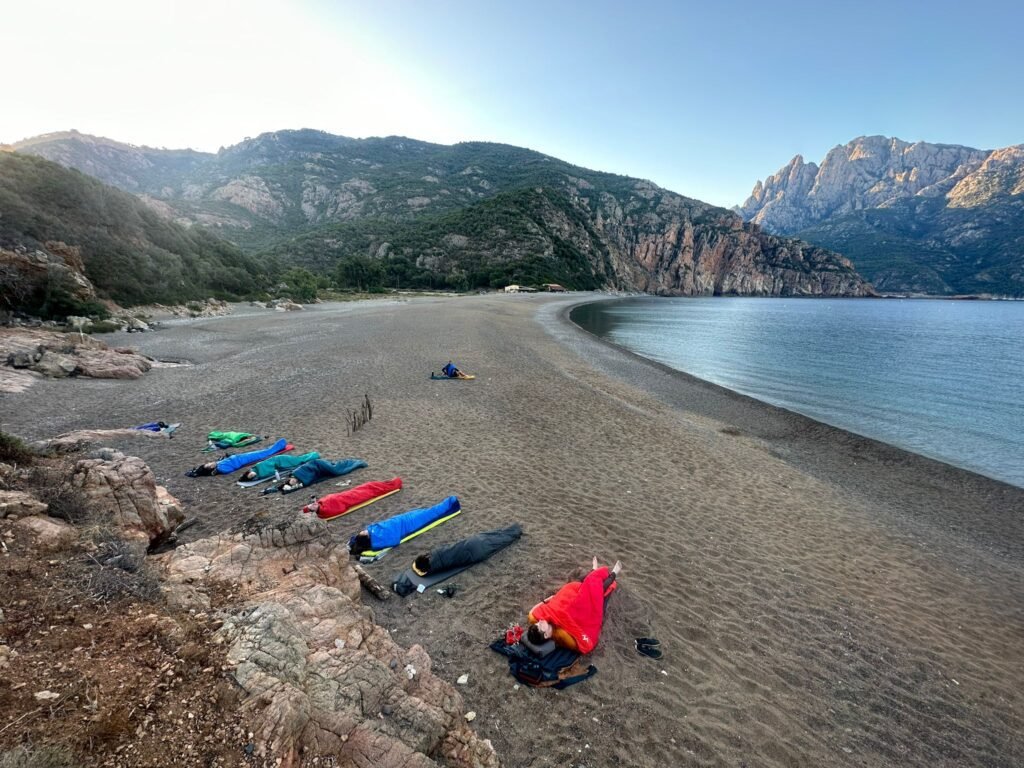
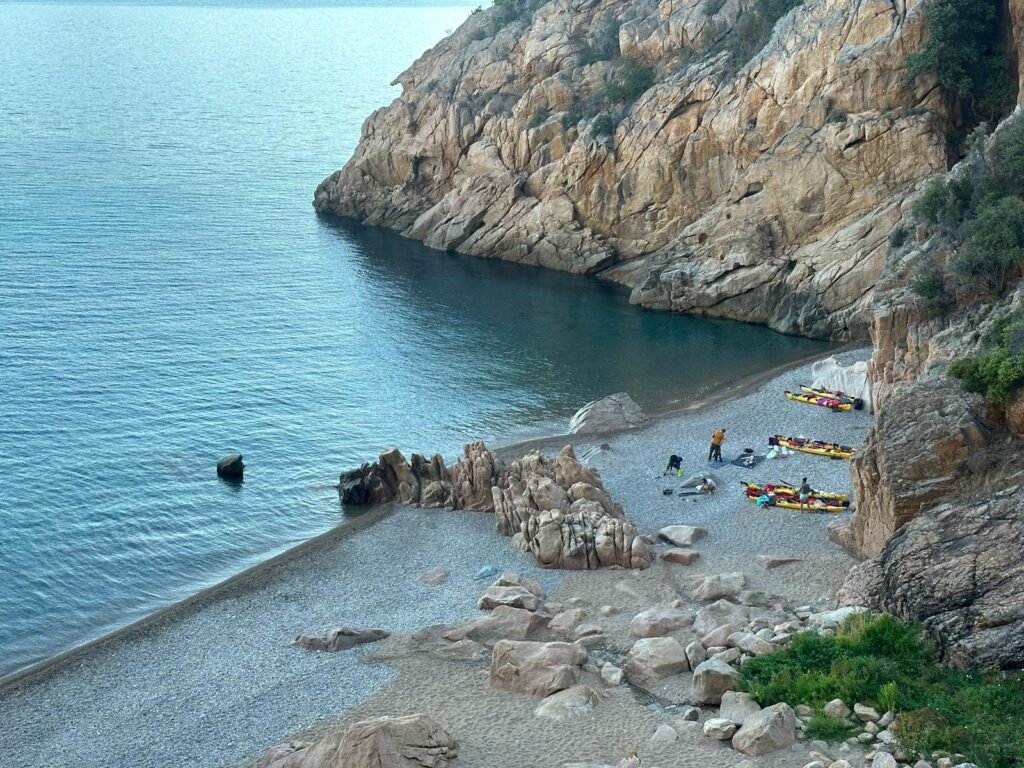
What about nature reserves ?
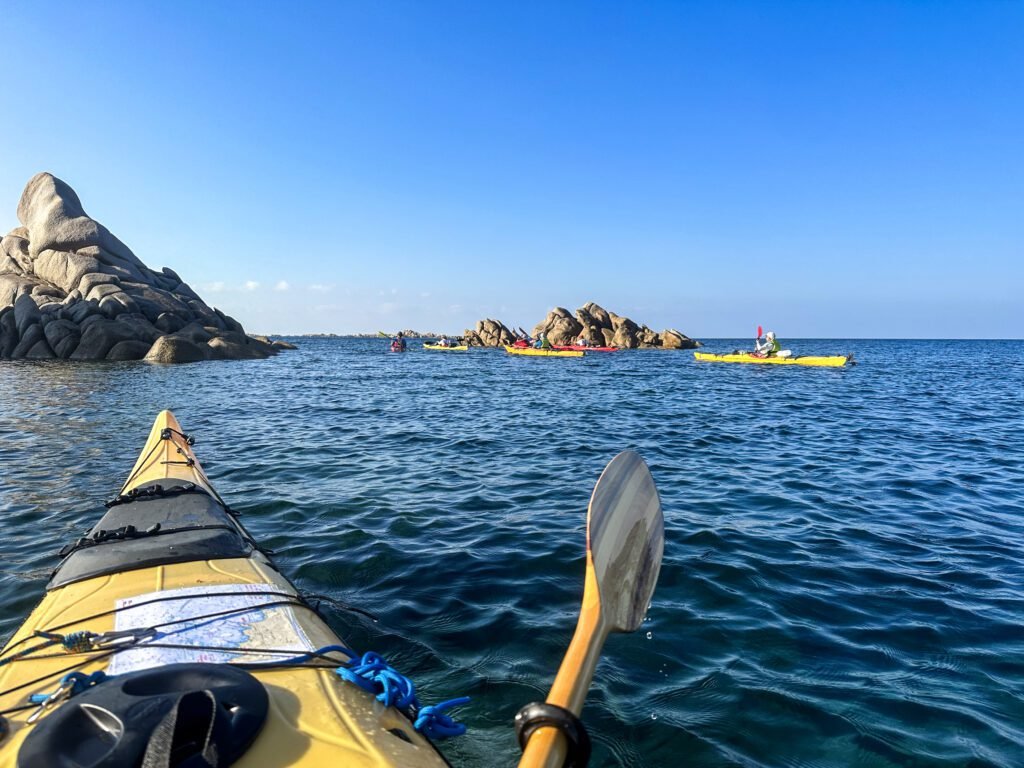
Somes beaches, especially the one that take part in the nature reserves (Scandola, Cap Corse, or the Bruzzi Islands and the entrance of Bonifacio you can see in the picture enclosed), are protected at different levels, ranging from the ban of bivouacking to the ban of disembarking. Campfire are also banned on the entire coast due to the dryness and the high risks of wildfires. The maquis is a thick, dense and a dry vegetation. When a wildfire lights up it can be spread in a blink of an eye. Some areas, such as the Agriates Desert, do not have a direct access and make firefighter’s work even more complicated. Such a disaster has tragic repercussions on the corsican biodiversity, which is very fragile. When it comes to cooking, a camping stove along wih a screen is advised.
Please note that night sailing is stricly forbidden. Be sure to prepare your itinerary in advance ! Furthermore, as unexpected events might occur, it is better to know emergency beaches to stop if needed. In the opposite, it is also possible to know beaches beyond your itinerary to set up alternative places to stop if you feel the desire to keep on sailing !
Strict rules when it comes to the corsican biodiversity
Corsica is known for its exceptional biodiversity. Prefectoral decrees protect some species. This impacts the sea kayaking practice along our coasts and people have to adjust their itinerary. For example these decrees protect ospreys. These prefectural decrees are to be taken into account during the entire nesting period on very specific areas. It is not possible to sail at least at 250 meters from a nest. The anchorage is also forbidden from May the 1st to July the 31st, and even to the end of August if needed.
These decrees protect at least 10 nests located between Calvi and Cargèse, in the Scandola Nature Reserve and the Calanques de Piana. Other decrees are effective the entire year and protect nests located in the Cap Corse area. The app Nav&co will help you to know the current regulations, as well as the protected areas. When you set up your trip, please check the protected areas in order to not disturb the birds !
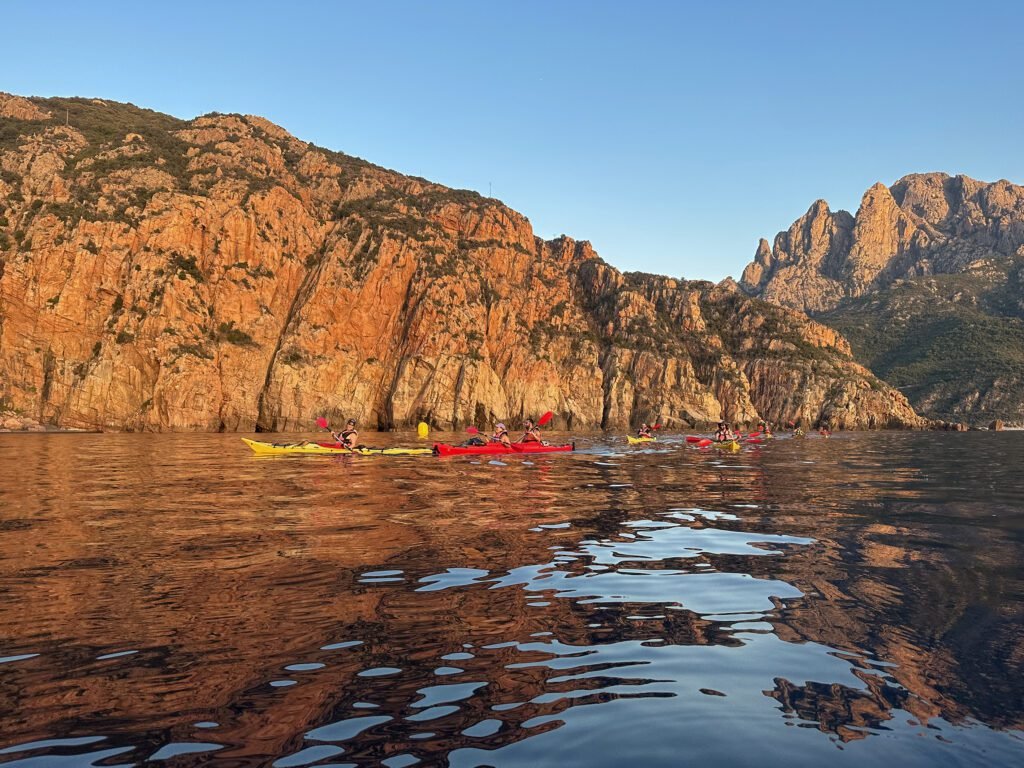
As explained in this article, there are laws that manage the sailing all arount the Corsican Island. Practicing sea kayaking in Corsica involves territorial and material constraints. The current regulations about the material constraints is about to be spoken about in another article !
Go hiking in the Calanques de Piana : the 3 best hikes to do
You must certainly have heard of the Calanques de Piana, a well know area that is listed as a UNESCO World Heritage site. The Calanques stand between Ajaccio and Calvi, on the West Coast of Corsica. The incredible contrast off its blazing red and the turquoise water of the sea have made this area very famous. Hiking in the Calanques de Piana is now an major activity here in Corsica.
There are many ways to discover the Calanques de Piana. For example you can cross them by car with the one and only road that linksPiana to Porto, by the sea thank to our guided stay Les Calanques de l’île de Beauté, or by boat with one of the many compagnies based in Porto.
In this article, we give you up the 3 best place to go hiking in the Calanques de Piana.
Capu Rossu and the Tower of Turghiu, an amazing overview on the Calanques de Piana


Above all the most famous hike around the Calanques de Piana is Capu Rossu. In the heart of the Calanques de Piana, you will walk along the coastline in order to reach the well-known Tower of Turghiu that overlooks the Calanques.
Summit : Tower of Turghiu – 330m
IGNMap : Ref. 4150OT
Starting point : 42.235398698061616, 8.583264900027201.
Round trip
Distance : 7,8km
4h of walking
Elevation gain : +454 – 456
Itinerary
In order to reach the starting point of this hike, you will have to ride on the winding routes that links Piana to Arone. After 15 minutes driving, you will catch sight a car park on your right. The breathtaking landscapes you can admire on the road gives you a taster of the panorama you will enjoy during the hike.
First, you have to follow the path that goes West to enter the nature reserve of the Parc Naturel Régional de Corse. During the entire hike, you can catch sight of the Genoese tower of Turghiu. You can enjoy an amazing view on both gulfs that surround the hike. The second option is to follow the coastal path. Therefore this hike is 30 minutes longer than the first one.
After a walk of an hour and a half, you finally reach former sheepfolds. There start the ascent to the summit to reach the Genoese tower. The path is even more technical as a part of is climb is made of scree. The more you climb, the harder it is to find the path. You have to scrupulously follow the cairns to reach your goal. Once you arrive at the tower, you can admire an overview on the Calanques de Piana and the Monte Senino, on the Gulf of Porto and the Gulfe of Arone.
To go back to the start, you have to follow the same path you just did. Once you reach the parking, it is time to enjoy a well-deserved refreshment on the restaurant while admiring the tower you reached before.
Please note that this hike is very exposed. In short, we do advise you to hike early in the morning, or in the late evening to enjoy the sunset. Make sure you have enough water.
Capu d’Orto : an overview on the Gulf of Porto and the Calanques
The hike of Capu d’Ortu offers as many various and spectacular landscapes as you can imagine. This summit overviews the sea on one side and the mountains on the other side. In this way, it allows you to admire the manys factes of Corsica, meaning an is a mountainous island surrounded by the sea. As a reward of your efforts, you can admire a breathtaking view on the Gulf of Porto, the tower or Capo Rosso and all the massifs of Corsica. Instead of hiking in the Calanques de Piana, this hike allows you to overlook this amazing place !
Summit : Capu d’Ortu – 1253m
IGNMap : Ref. 4150OT
Starting point : N 42.2397° / E 8.654744°
Round trip
Distance : 12km
6h of walking
Elevation gain : +848 – 847

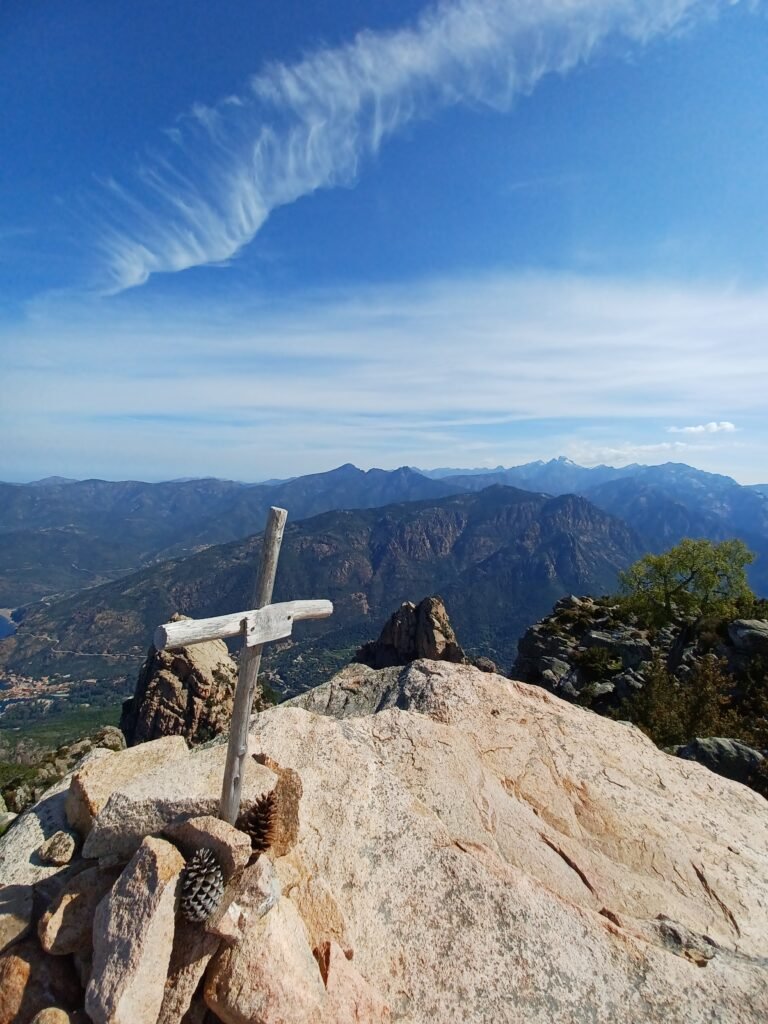
Itinerary
The hike starts at the football stadium of Piana. From there you alternate between walking at the heart of the maquis and in a pine forest. Then you enter a path made of red scree, the Calanques de Piana’s main characteristic. As you follow this stony path, you can already admire an amazing panorama on the mountains. The crossing of two cliffs allows you to reach another forest. The Gulf of Porto finally starts to appear.
Now starts the climbing part of this hike. Please don’t be affraid ! There are cairns to follow in order to not get lost. Even if you will need your hands to reach the summit, this part remains easy. Once you reach the summit, you can enjoy an overview on the Gulf of Porto, the tower of Capo Rosso and the Calanques de Piana, and on the other side the entire mountain ranges of Corsica.
To go back to the start, you have to follow the same path than the one you followed the entire outward journey. Please follow carefully the cairns in order to not get lost in the stony part to reach the path in the pine forest.
Capu di U Vitullu, to overlook the Calanques de Piana


The summit accross from Capu d’Ortu is named Capu di U Vitullu. This is the place we are heading forth now.
Summit : Capu di U Vitullu – 1298m
IGNMap : Ref. 4150OT
Starting point : 42.236685116774765, 8.639537863408233. Start at the healthcare pathway above the city hall of Piana
Round trip
Distance : 14.58km
7h of walking
Elevation gain : +944 – 943
Itinerary
This hike starts in Piana. You have to follow the healthcare pathway which is above the city hall of Piana. It allows you to reach the official start. You can either start from the football stadium of Piana, such as Capu d’Ortu. The path weaves into the maquis and leads to a pine forest. Then you reach a red rocky path that refers to the Calanques de Piana.
Once you reach the crossing you have to follow Vitullu on your right. The other way will bring you to Capu d’Orto. You start you first ascent to reach the first col. From this place you can see the Gulf of Porto and the village of Piana, as well as the valley on the other side. Then you follow a sloping legde that overhangs the valley. Once you are in front of a rocky cliff, you must go around to the left. Then, you have to find a breach on the right to keep up walking. Then you need your hands to finally reach the summit. There you finally face a structure, this is an IGN sign. There, you can take the time to admire the Calanques de Piana and its Geneose tower, the Gulfs of Porto and of Arone. With a clear weater, you might be able to see the Paglia Orba and the Monte Cinto.
Bonus : La Tête de Chien, sunset above the Calanques de Piana
Summit : Capu di U Vitullu – 1298m
IGNMap : Ref. 4150OT
Starting point : 42.25289586280025, 8.657440014421619 Start at the parking at the corner next to La Tête de Chien
Round trip
Distance : 2.3km
1h15 of walking
Elevation gain : +65 – 54
Itinerary
We talked about emblematic hiking paths in the Calanques de Piana above in this article. Here is a little walk as a bonus ! The starting point is on the road between Porto and Piana, next to the famous rock known as “La Tête de Chien”. At first you have to walk on a stony path in the shade of a beautiful forest. As the elevation gain is insignificant and the walk quite short, this walk remains accessible. At the end, the path leads to cliffs. There you can admire a wonderful sunset above the Calanques de Piana and the Gulf of Porto. Please do not forget to bring headlamps to do the hike the other way and find back your car.
Sea kayaking in Corsica : Circumnavigation of Corsica
Sea kayaking around Corsica : the projet
Put theory …
I visited Corsica many years ago on a climbing holiday and remember clearly thinking at the time that it would be a great place for sea kayaking. Thirty years later I eventually made it back with a plan to paddle all the way around this amazing island. I work as a sea kayaking guide on Sherkin, a small island off the southwest coast of Ireland. I run my business, H2O Sea Kayaking, there during the summer months where I run half-day tours, full-day tours, 3-day sea kayaking safaris, and bespoke training and skills workshops. My busy season starts in June so with my wife, Tina, we decided to go to Corsica in mid-April and gave ourselves a month to complete our expedition.
The planning started months beforehand and the first task was to find somewhere we could hire suitable kayaks. We had decided early on that we were not going to try to bring our own from Ireland, simply due to the logistical challenge. I contacted every kayaking provider I could find in Corsica and asked them all the same question – could they hire me two kayaks for a month in April/May? One of the few that responded was Cors Aventure.
… into practice
I started a conversation with Pierre Francois and then later, Marion. They were both very helpful in the lead-up to our journey. They have a good selection of kayaks to suit people of different sizes so we were able to pick two that suited us.
In the weeks before our departure, our house was full of camping and kayaking gear all over the place. We pulled out our tent, sleeping bags, paddling gear, and bought some new pieces of kit to bring with us. On departure day we had 30kg of bags each ! We traveled from Sherkin Island to catch two flights from Dublin and then Nice to arrive into Ajaccio late one Wednesday evening.
The next morning we met with Pierre Francois and Marion. They would become our guardian angel during our trip. The kayaks were perfect – big stable Prijons with rudders and large wide-opening hatches. They weren’t speed machines but they were perfect for our purpose.
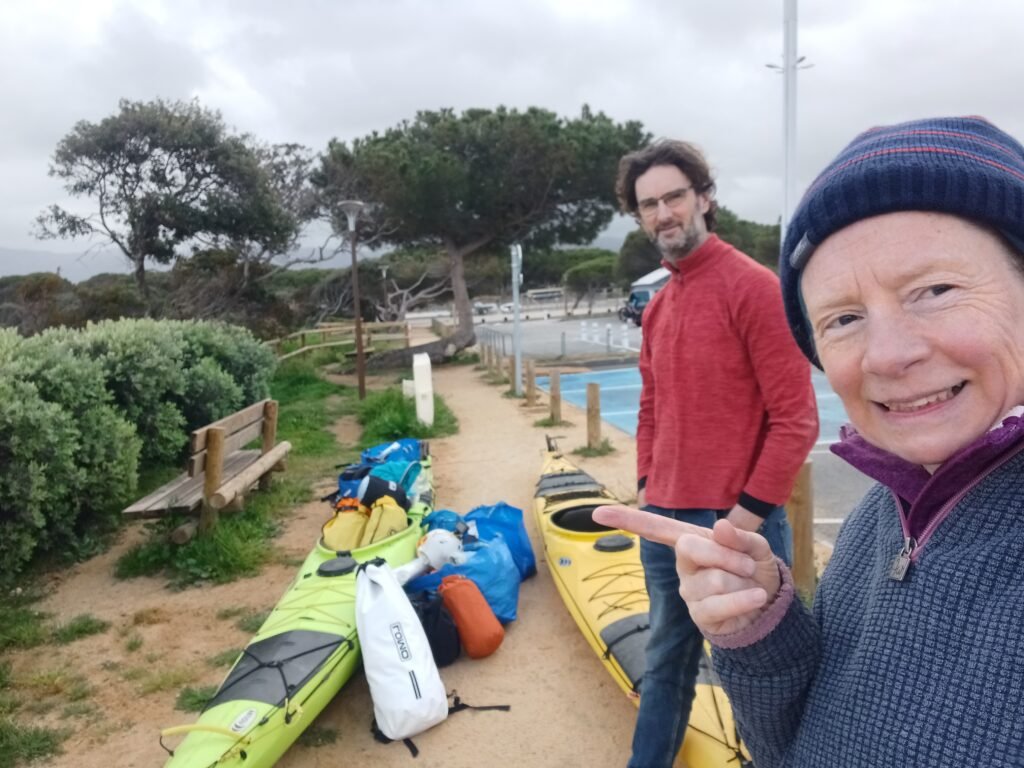
Sea kayaking in Corsica : first stages under the storm
Sea kayaking on the Mediterranean : how to summon your patience
We were ready to get in the water – but unfortunately, the weather was not ready to let us go. The wind and swell had been strong for days and there was no sign of it abating. We booked into a chalet in a nearby campsite and waited. On Saturday, Pierre Francois dropped us down to the beach at Isolella with our kayaks. The swell was still too big with surf breaking on the beach. We knew conditions would be a lot more difficult around the first headlands. The only thing we could do was wait. When darkness fell we put up a tent and waited until morning.
– A note on wild camping. Our understanding is that wild camping is not permitted in Corsica, especially in the Nature Reserves. On the other hand, bivouacking is allowed. The difference is subtle – you can have a tarp over your head and a ground sheet – just not a tent. We did break the rules by having a small tent, but only erected it late in the evening and were gone early the next morning and followed a strict “Leave No Trace” policy.
The first sailing in Corsica

At last on Sunday morning, the conditions had improved. Not flat calm by any means, but much better. We packed up and were on the water by 08:30 am. As we cleared the first headland the swell picked up. It was big enough that we sometimes couldn’t see each other if we were both in the troughs of the waves. That’s about 1m of swell. It was exciting – for now ! As we crossed from Punta di a Castagna to Capo di Muru, the swell increased. As did the wind. This was a committing crossing with over 10km before we could land.
Being our first day on the water this was not ideal. Tina started feeling seasick but also terrified, which did help to quell the nausea ! I stuck close to her, urging her along as the waves bounced us around until we eventually rounded what we came to know as Cap Guardiola. As soon as we did we were in calmer waters and found a beach we could land on. It was a surf landing on a steep beach which made it tricky but we were soon settled into our campsite for the night. It was the first of many isolated beaches that we had all to ourselves.
The Southwest coastline and the arrival at Bonifacio
Sea kayaking in Corsica : sailing around the Southwest coast
Our second day was a complete contrast to Day 1, with calm seas and light winds. This was more typical of the conditions we had over the rest of the journey, though there were a few days when the swell and wind picked up again. After the excitement of the previous day, we took our time packing up and got on the water mid-morning. With the best will in the world, between waking and paddling away from the beach, 2 hours will pass, though by the end of the trip we had become more efficient and had cut that down to 1.5 hours.
At a relaxed pace, we paddled on southeastwards to Porto Pollo where we stopped in the hope of resupplying. Why we needed to restock so soon I have no idea ! A pattern soon emerged, that we would stop for supplies every 2 or 3 days. The supermarket was closed for a long afternoon lunch. This is something we’re not used to in Ireland but soon got used to it.
The harsh reality of sea kayaking in Corsica
After a nap on the beach, we headed on. We had the choice of following the coast inland towards Propriano or cutting straight across the bay to Campomoro. A distance of about 9km. When deciding our route we considered whether there would be good spots to camp for the night away from built-up areas but also with safe places to land. We could see breaking surf on the beaches near Propriano so made the call to head straight across.
This was still a relatively long crossing, especially considering our training in preparation for the expedition consisted entirely of “wait training”. In other words wait until we get there ! It was a two-hour crossing and by the end of it, Tina was exhausted. She won’t mind me saying this because by the end of the trip, she was super fit and was showing off her muscles to everyone ! The beach we landed on was very public. We waited until dark to put up the tent. Most of the time we managed to avoid camping in such public places but it was unavoidable this day.
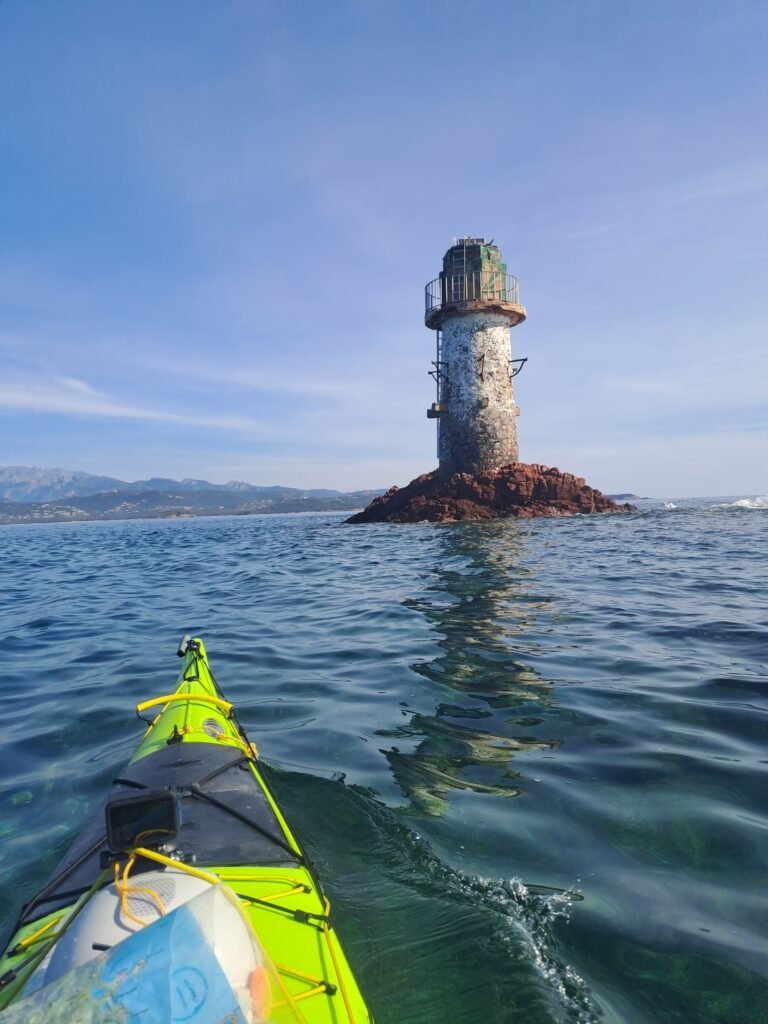
Sea kayaking in Corsica : Bonifacio and its amazing cliffs
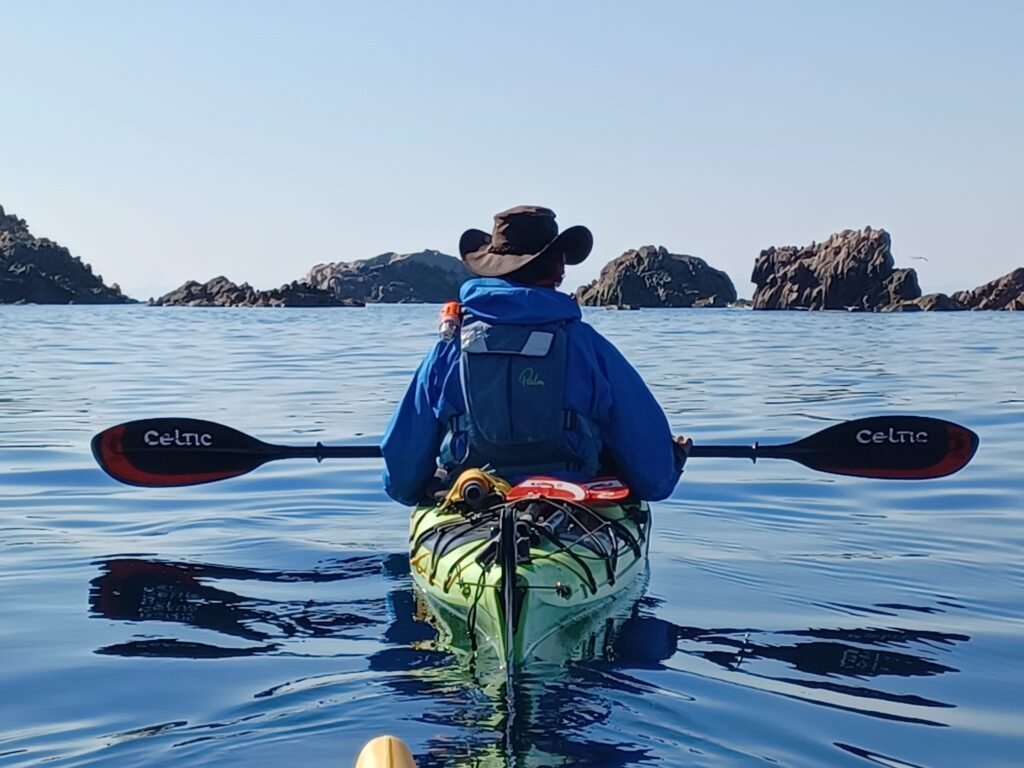
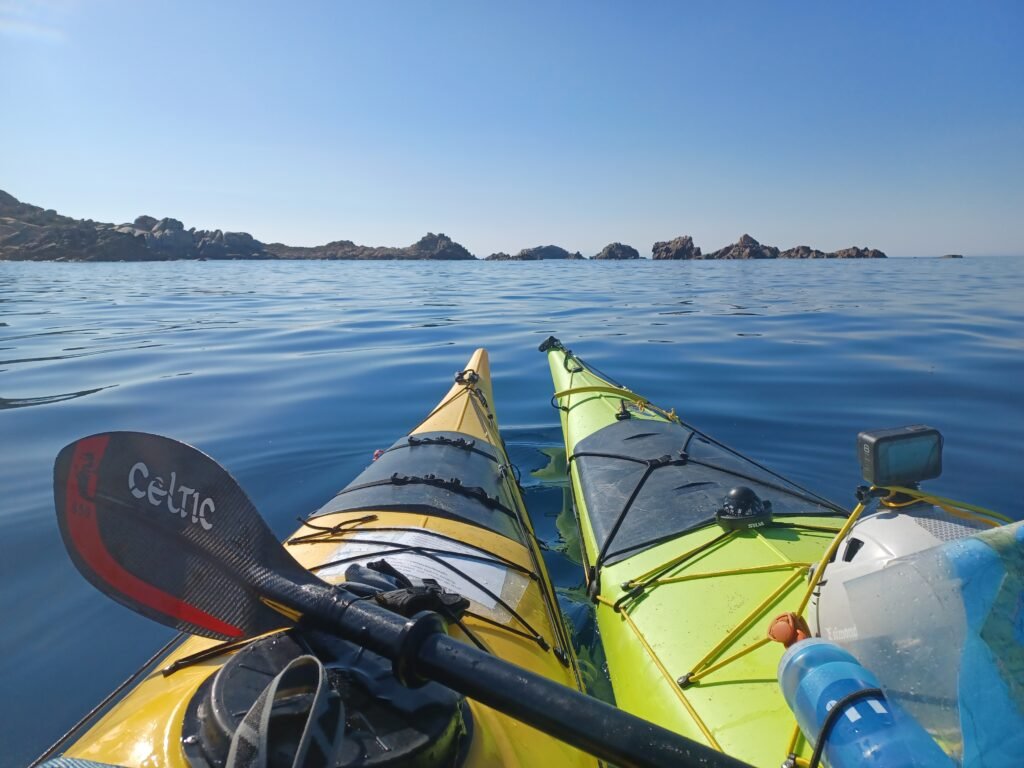
Before we started out on the trip we had agreed with Marion to keep her updated on our progress via WhatsApp. We sent her brief updates most days. She would let us know about any weather systems coming in that might cause us problems. We did keep a close eye on the forecasts ourselves too, of course. But it was fantastic to have her local knowledge.
The next few days were spent paddling along the beautiful and remote coastline from headland to headland where the sculptured granite rock was the backdrop until we approached Bonifacio. There the geology changed dramatically to the famous limestone cliffs this area is known for. While the port of Bonifacio is beautiful, the marine traffic, noise, and general busyness of the place meant we were happy to leave after we had stocked up on food and water. We enjoyed meandering along the cliffs and into mind-blowing caves straight out of the movie “The Beach”. After less than 10km, the limestone cliffs dropped away to a less spectacular but still pleasant coastline.
Sailing around the Eastern coast and our daily organisation
Bivouac ont the Corsican Coasts : some rules need to be followed
As the days continued, a similar pattern emerged. We woke with the daylight and I packed away the tent and sleeping bags. Tina would make our breakfast of cereal and tea, and sometimes sandwiches for the day. We were usually on the water before 8:30 and would paddle a couple of hours before stopping for a morning tea break. We usually didn’t have a fixed destination for the day but instead had a target distance we’d like to cover, which increased as our fitness levels improved.
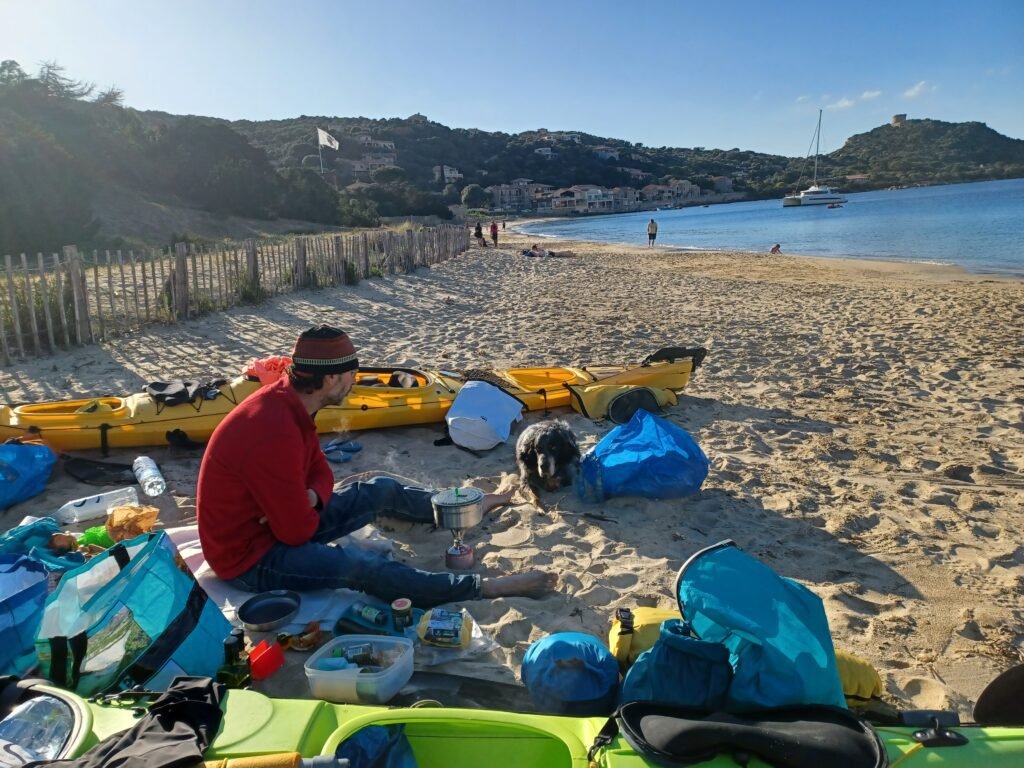

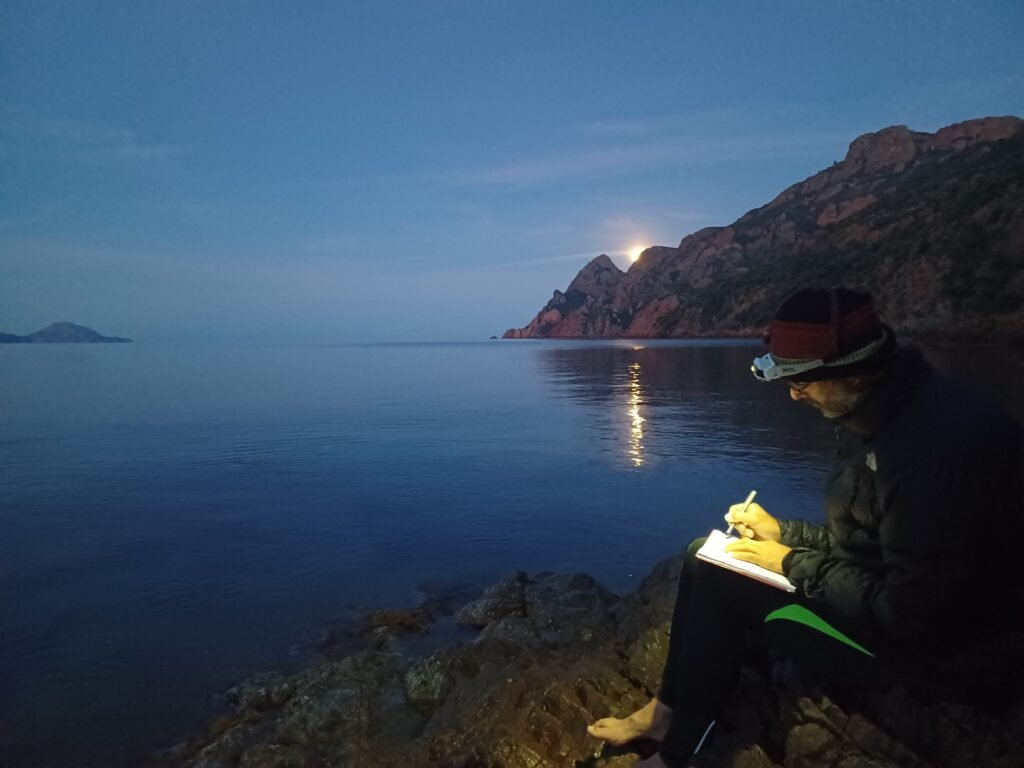
I kept track of our speed and distance with a handheld Garmin. I would give Tina “status updates” as we paddled along. We stopped for an early lunch and then an afternoon tea break too… it was very important to manage the tea levels. This became a central theme of our trip!
By mid-afternoon we were on the lookout for a campsite for the night. We were usually installed somewhere by 4:00 pm, watching the world go by, writing up the diary, and cooking up a dinner of veggies, lentils, rice, or pasta. If we weren’t in a nature reserve we would often light a fire on the beach with the abundant dry driftwood on the beaches – always being very careful and with water nearby to put it out quickly if needed. Later in the full height of summer, campfires on the beach probably would be a bad idea due to the high risk of brush fires. We were asleep in our tent by 9:00 p.m. and always slept like logs with the sound of the waves always in the background.
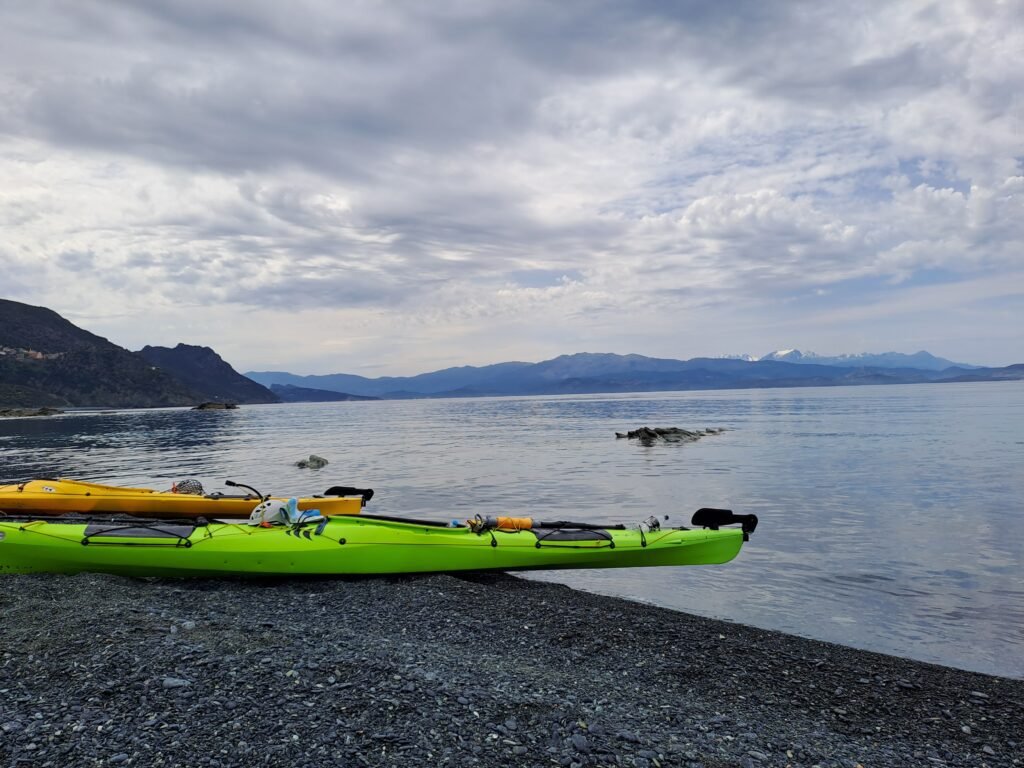
Sea kayaking in Corsica : go off to discover the Eastern Coast
A main feature of the east coast of Corsica is a beach that’s about 100km long. It is broken up only by towns, small rivers flowing out, and the ubiquitous towers on anything resembling a headland which are dotted the entire way around Corsica. I had initially not been looking forward to this section of our expedition because I thought it would be a bit monotonous. However, while there was a degree of “sameness” about the landscape, the views of the mountains in the distance were always present. The changing sea state provided enough variety to our days. The wind and swell picked up as we made our way northwards which gave us some excitement as we launched and landed through surf.

On the 9th day of our trip, there was an offshore wind and breaking surf so we stopped for a break after 7km. We took the remainder of the day off to rest and chill out. One notable campsite was when we found a river flowing into the sea. Most of the rivers we came across were so shallow and dry it was impossible to travel upstream. The Bucatoggio river was a little different. Despite only being 10km from source to sea there was enough water to paddle upstream for a couple of hundred metres at least.
We set up camp in the trees, away from the persistent sound of the sea – which was nice. However it was also good to have a change. We washed ourselves and some of our salt-encrusted gear in the fresh water. Then we settled in for a peaceful night…until a couple of scops owls decided to have a chat… all night long. The scops owl has a call akin to the most boring phone call tone available. It is repetitive in the extreme so our sleep was not so sound that night!
Sea kayaking in Corsica : sailing from Bastia to Calvi
The Cap Corse area
We landed in Bastia on a busy morning to the sound of the church bells ringing in the old harbour. We were in search of gas for our stove. Indeed we were running low on the ones that Pierre Francois had bought for our MSR stove before we arrived. Gas being one of the things that we couldn’t bring with us on the plane. In the end, we simply couldn’t find it. We ended up buying a simple stove with amore readily available canister.
For the next couple of days, we paddled northwards to one of the more notorious parts of the Corsican coast – the Cap Corse. This is the most northerly point of the island has a reputation for strong winds and big seas. As it turned out for us, we had ideal conditions with the wind at our backs or flatcalm seas which we made the most of. Once again the landscape changed here. The Cap definitely has a more rugged, remote feel and there are several long stretches where it would not be possible to land in rough seas.
Just north of the tourist town of St Florent we stopped at a proper campsite right on the beach. We had our first hot shower in two weeks. It was the best shower ever ! The next morning we paddled into town to resupply. The next part of our journey around the Désert des Agriate was very remote, with no towns or roads for over 40km. If we were forced off the water by bad weather we’d need some food in reserve to see us through. The weather was getting unsettled for sure.
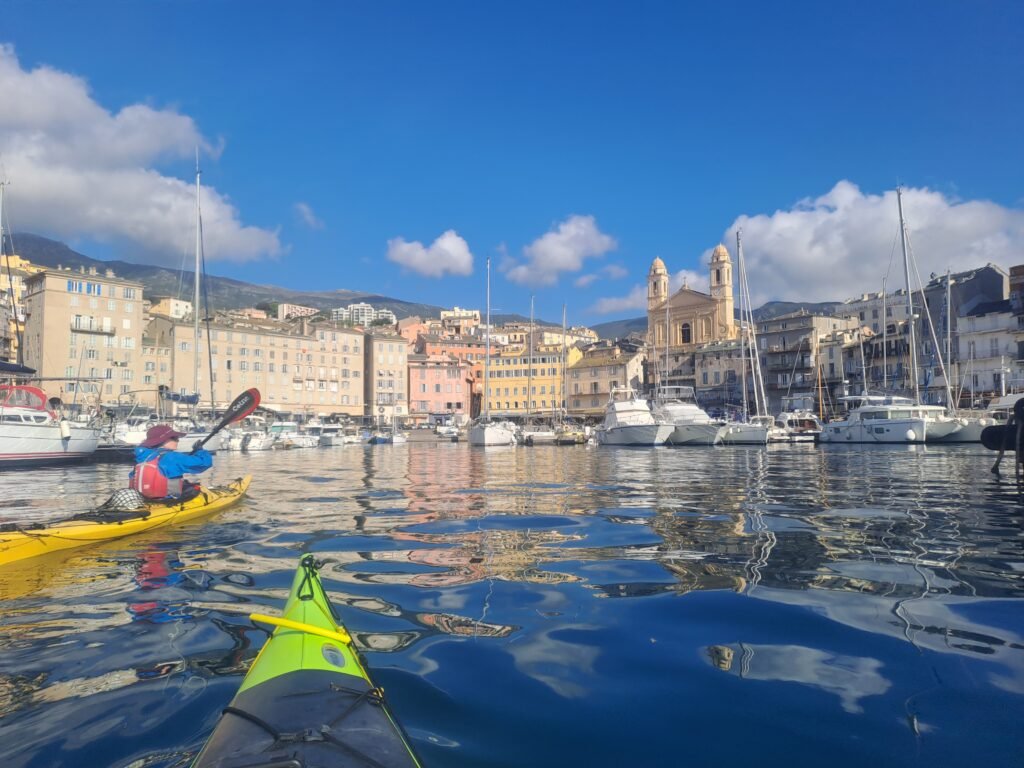
Sailing around the famous Agriates Desert
We paddled out of St Florent with a good wind at our backs and then turned east along this stunning coastline with pristine beaches and blue waters even though it was overcast and drizzly. In the high season, there is no doubt that there would be throngs of yachts and powerboats moored here with hundreds of people sunbathing and swimmers in the water. But we had the whole coast almost entirely to ourselves apart from a couple of hikers on a coastal path.
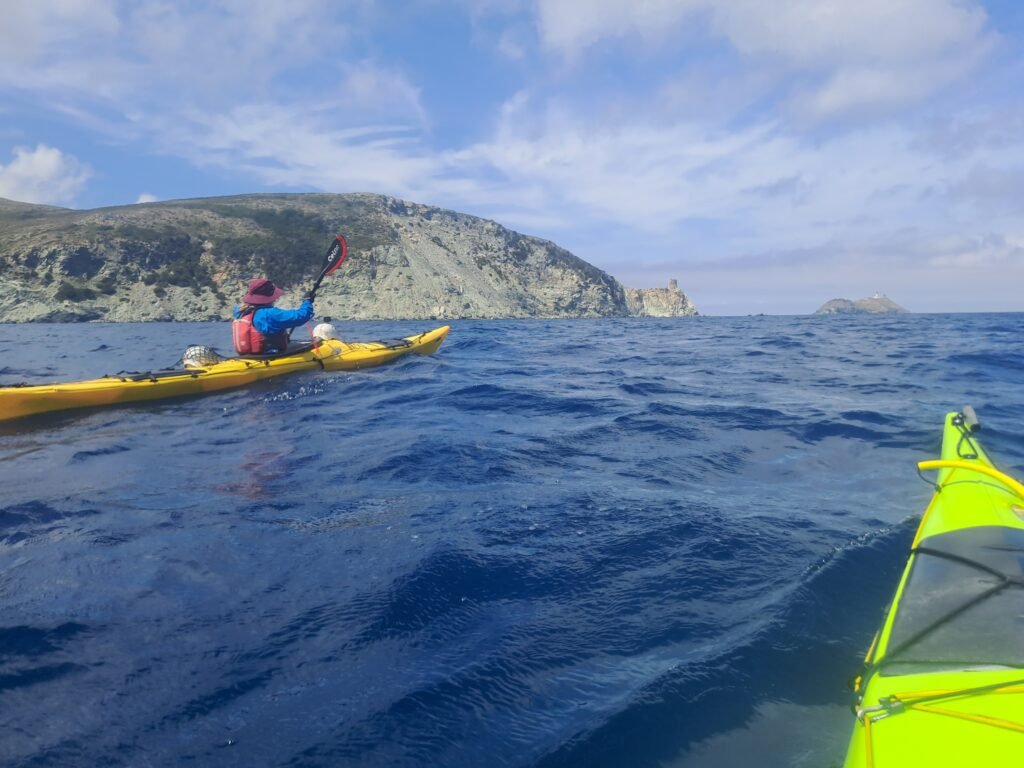
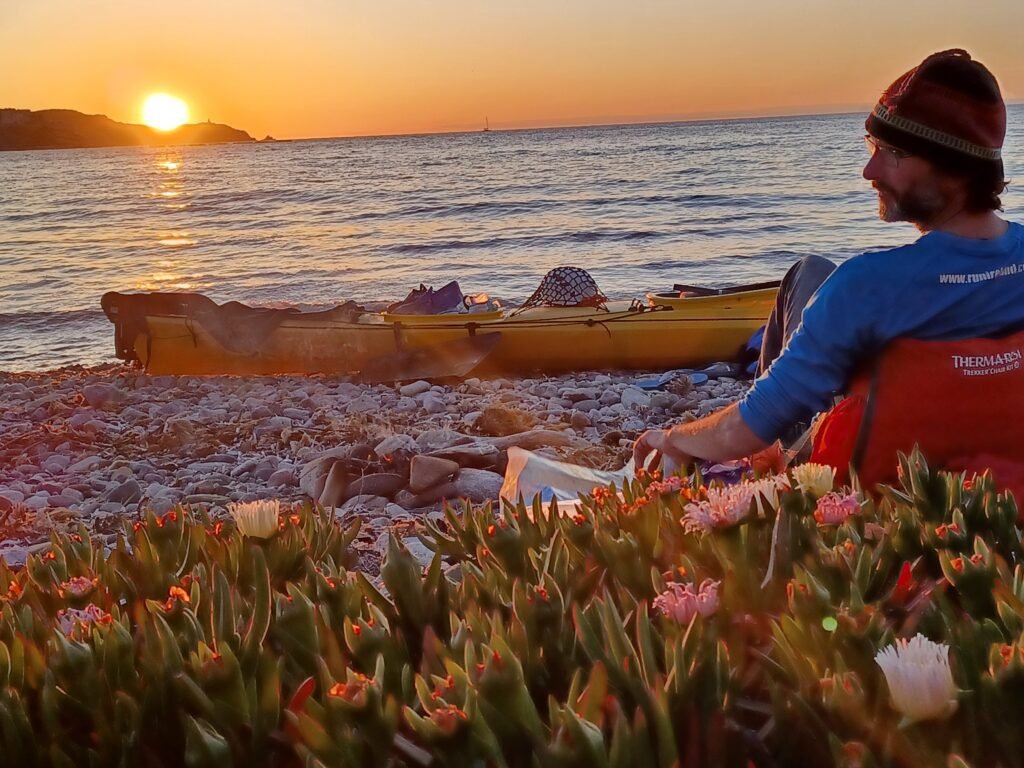
We camped in the rain that night in a grassy field. Our first night not camped on sand or gravel so far. Tina refers to as the “cow shit” camp! It’s not inaccurate but – hey – it’s wild camping!
Over the next couple of days, the weather worsened. By the time we arrived at Ile Rousse we had to land through sizeable surf on a beach. We ended up taking our first and only full day off the next day. It was a well-earned break which we used to read and write up our diary as well as top off our supplies for the days ahead. The swell had not dropped by the next morning, though the wind had subsided. I had some fun in the surf, catching a couple of nice clean waves before the serious work of the day got underway.
The arrival in Calvi

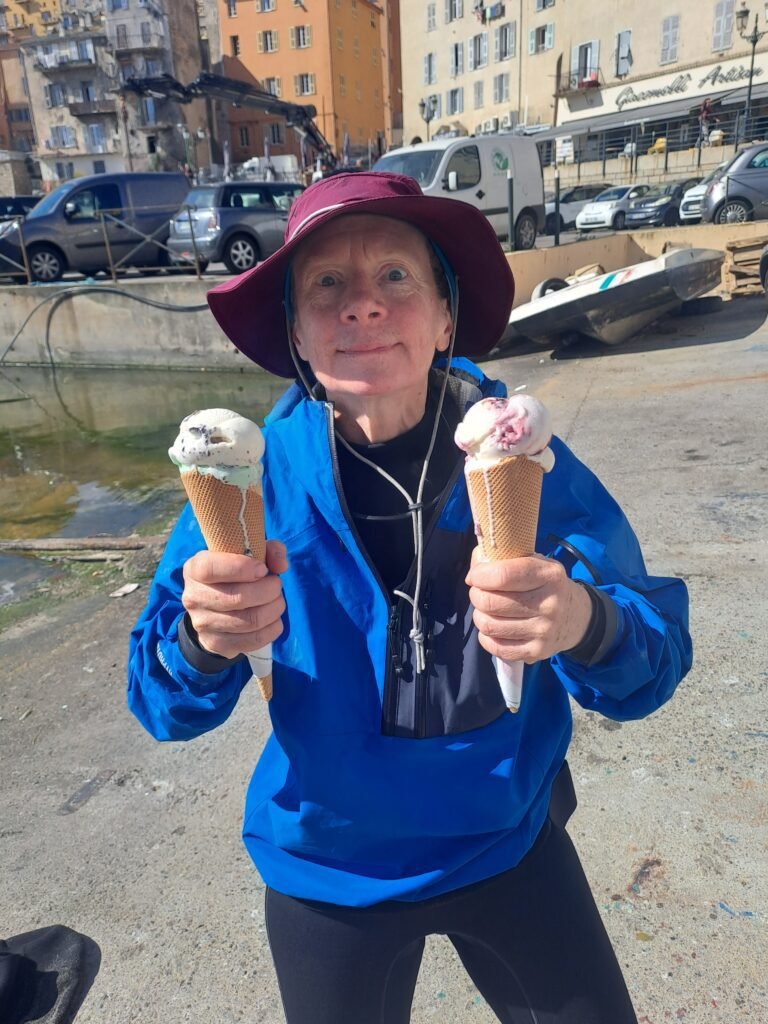
The wind and swell both picked up as the day went on. By the time we arrived in Calvi we were ready for a huge ice cream while sitting outside a fancy café on the waterfront, dressed in our full paddling gear while getting some funny looks from the well-heeled tourists ! Because of the lack of a quiet spot to camp for the night, and deteriorating conditions on the water, we had to backtrack. We were fighting against the wind for an hour to find a spot to put up our tent. Our reward for that was the most amazing sunset behind the citadel of Calvi.
Sea kayaking in the Scandola Reserve and the Calanques de Piana
The Scandola Reserve
The most scenic and striking part of our circumnavigation was over the next few days from Calvi to Cargese. In these 70km or so is the well-known Scandola National Reserve which we had heard about well before our arrival. It deserves the reputation it has earned as the high cliffs, deep caves, and untouched beaches are truly beautiful. We arrived there early in the morning having left from Galleria. As we arrived, so did the first of the tourist boats ferrying people out from Porto in fast, loud vessels.
While we enjoyed the place – we were also glad to have arrived early to see some of the wonders in peace and quiet. We had our one and only run-in with the skipper of one of these speed boats when we stopped for a very quick bite to eat on a rock – there being no beach we could land on. He shouted abuse at us and threatened us with being fined for simply landing. Then he drove off with his clients in his loud craft, spewing fumes!
How majestic are the Calanques de Piana
The following day, (after stopping for the night outside of the Nature Reserve) we paddled into Porto, exploring our first through cave of the trip along the way, to replenish our stocks. We had considered just cutting across Porto Bay to save time and distance. However we were very glad to have explored that beautiful part of Corsica. It is a small town nestled in between mountains reminiscent of the Dolomites.
The headland of Capo Rosso was even more spectacular than Scandola and we were there very early in the morning having stopped nearby the night before. The maze of caves and channels running through the headland is so beautiful and fun to explore. We took our time lingering there, watching the swifts that nest on the cliffs before carrying on southwards.

To bring things full circle : back to Ajaccio
Sa kayaking in Corsica : The final push !
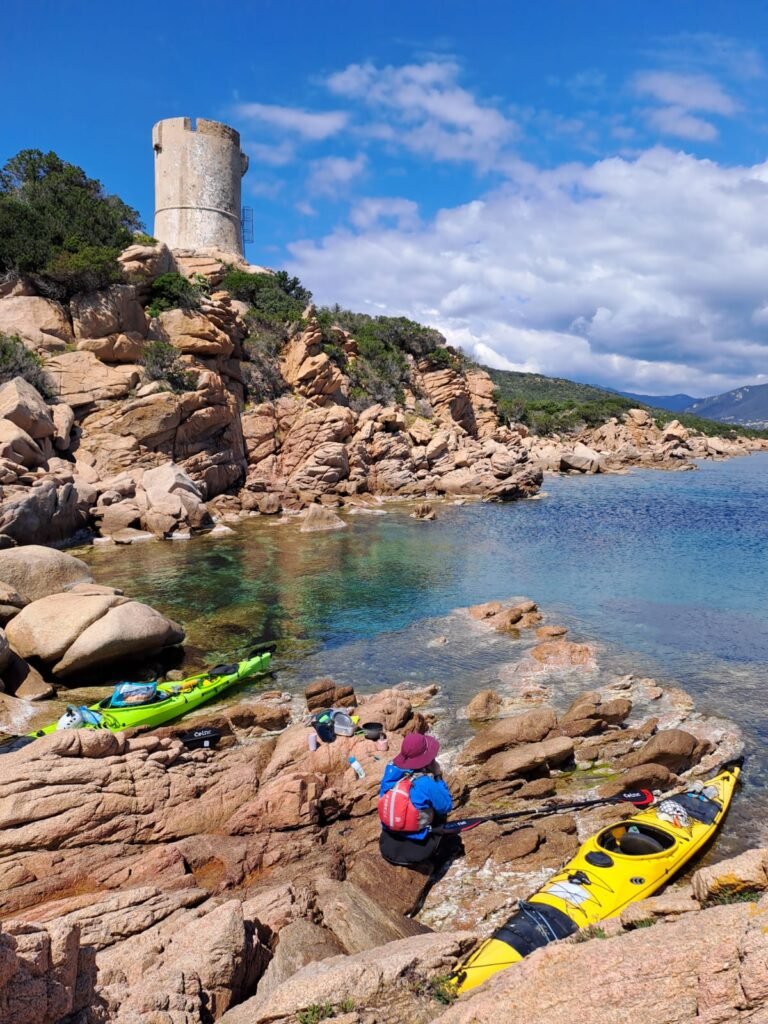
At the start of the expedition, we had lost three days due to bad weather. After that setback, we thought our chances of completing the complete circumnavigation in the time we had left were slim. But after a few days our fitness started to improve and our daily mileage increased bit by bit. Towards the end of the journey we paddled two days straight of 38 km. Much more than the average 20km per day we had initially envisioned. We are both competitive by nature so enjoyed pushing ourselves on days when the scenery was slightly less stunning !
On the last few days of the trip we were getting messages from Marion that there were some bad weather conditions coming in so this is when we really pushed on. The last thing we wanted was to be 10km from the end of the journey to find ourselves pinned down on a beach by bad weather. So we raced ahead to make sure that didn’t happen.
Back to the start : the end of the trip
When we rounded Pointe de la Parata into the bay of Ajaccio and in the distance Isolella we were over the moon. Our last camp was just 10km short of the finish line. While we were weary and looking forward to a hot shower, there was a definite tinge of sadness now that the journey was almost over. It had been an amazing journey.
The simple nature of the trip; waking, eating, paddling, and sleeping – repeat – was very special and something neither of us will forget. After 23 and a half days, we arrived back at our starting point after the longest crossing of the trip. Pierre Francois welcomed us at the beach where we handed back our trusty kayaks. We checked into the chalet again for our first night in a real bed for ages !
If you’d like to see a day by day account of our sea kayaking journey in Corsica. You can watch the full YouTube video here.
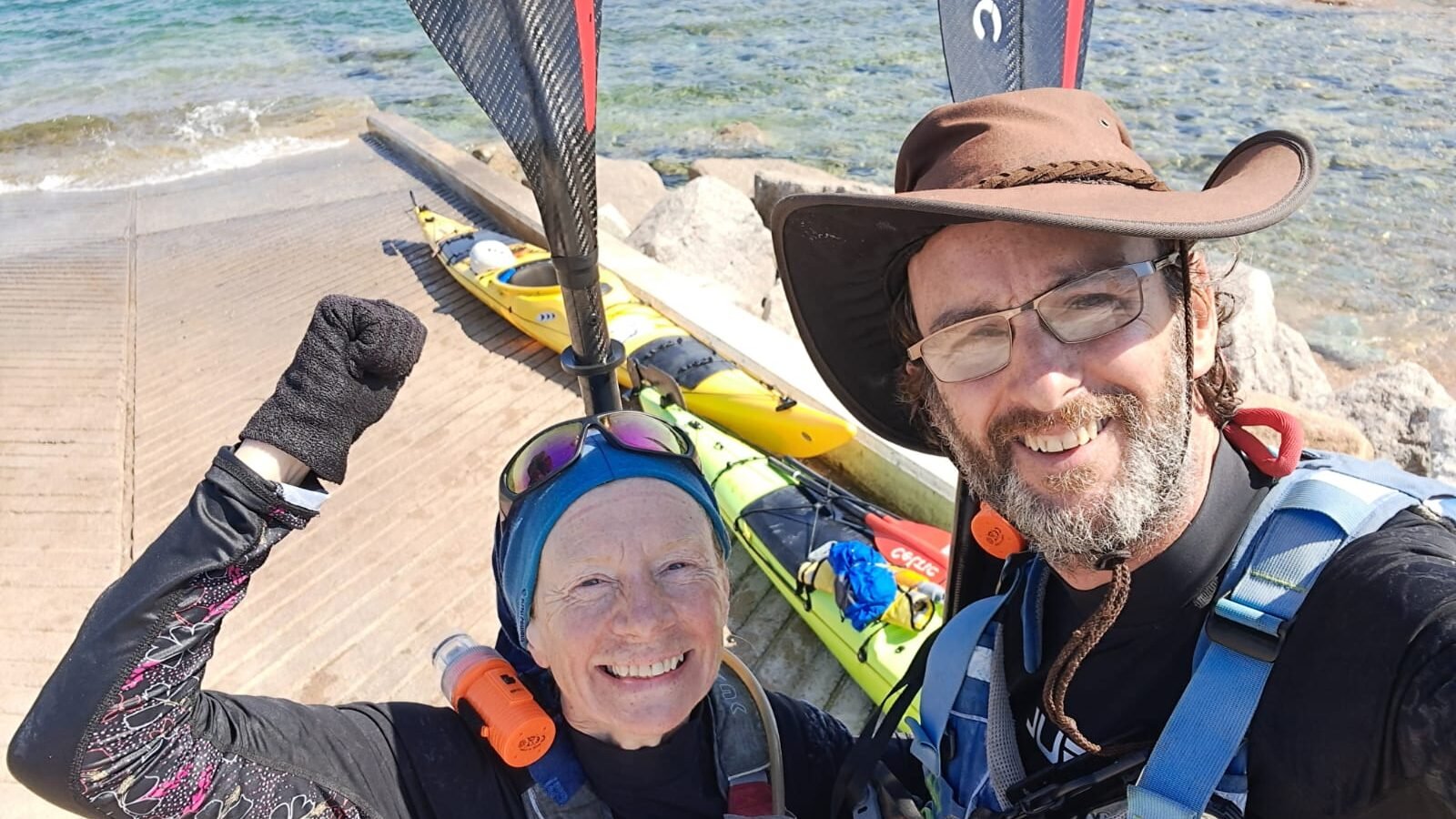
Tina and Pat took all these pictures and wrote this journal. All rights are reserved to them. We published their sea kayaking expedition around Corsica with their agreement. If you want to read their expedition in French, here is the translated article !
Sport activities in Ajaccio : the 5 best outdoor activities in Ajaccio
Let’s find out the sport activities you can do here in Ajaccio and in the surrounding area ! Some decide to rest during their holidays while others prefer to see where the wind takes them to discover the place in a different way. Here is our guide to find out the best sports activities to discover Ajaccio and its surroundings !
Accessible sport activities in Ajaccio : hiking and trekking
Corsica has a lot to offer regarding the possible sports activities that can be done. The gentlest and the most accessible sporting activity certainly remains hiking (and trekking). Fortunately, Ajaccio offers a lot of hikes suitable for all levels

The Monte Gozzi
Emblematic cliff hear in Ajaccio, the Monte Gozzi stands out thanks to its red color. This hike is accessible for beginners and offers a breathtaking panorama all over the gulf of Ajaccio. You start hiking at the Saint Cyr chapel. This hike starts with an ascent before a flat path surrounded by the well know corsican maquis. The last part leads you to the summit and its corsican flag. If you want to hike further, you can turn left to reach the Punta Pastinaca. Our best advice ? To hike in the late afternoon to admire an incredible sunset upon the gulf of Ajaccio.
The Monte Aragnascu
Also named Monte Ignascu. This hike is very easy and accessible. You stark walking under a shady path in the maquis. Then, after an ascent, you reach an increadible panorama on the gulf of Ajaccio on one hand, and on the Monte d’Oro mountain range on the other hand. The starting point is located in the lovely village of Cuttoli-Corticchiato. Count on two hours to reach the summit and approximatively 1h30 to go back to the starting point.
The Crest path : le sentier des Crètes
This path leads you towards the montains that overhang the entire city of Ajaccio. The starting point in the city center allows all hikers to get to it without using a car. Up there, you can choose between a lots of pathes. You can reach the Parc Berthaud and its flage, climb to the high ridges, reach the rig that offers a view on the Iles Sanguinaires…The choice is all yours !
The coastal path, le sentier des douaniers
This coastal path allows you to walk along the steepy cliffes from the peninsula of La Parata to reah the beach of Capo di Feno. The hike offer a view on jagged and wild coast which is very specific of this area. Our advice ? Clim the dozen of stairs to reach the Genoese Tower of La Parata to enjoy a breathtaking view on Les Îles Sanguinaires !
Escalade, climbing, outdoor and indoor sport activities in Ajaccio !
For those who perfer to clim cliffs, there are plentiful of places to climb in Ajaccio and its surroundings. These places are always in stunning landscapes and are accessible to all levels, whether you are a beginner or an experienced climber. There are 7 places where you can climb near Ajaccio among which five multi-pitch climbing spots, one bouldering free climbing spot, one big climbing route and two spots for traditional climbing.
The Monte Gozzi
This red cliff which overlooks Ajaccio is a well known climbing spot in this area, even the most popular one. The Monte Gozzi offers around a hundred of routes from the level 3b to the level 8a. Thanks to its exposure, it is possible to climb there during the entire year. The panorama is emblatic.
A Reta
For those who prefer to climb with seaviews, you might need to climb on this spot. This bluff made up of granit offers 9 routes from the level 4a to 7a. Because of its exposure we advise you to climb early in the morning or in the late afternoon during the high season.
Bloc Session Ajaccio
What about rainy days ? A bouldering hall opened in Ajaccio. For those who enjoy indoor climbing, Bloc Session Ajaccio offers 150 routes for all levels. The staff keep the routes often updated so that you can improve yourself without beeing bored. The entire team is always ready to help you whenever you feel the need. Little extra : the barbecue and climb events every week during summertime.
The Via Ferrata of Tolla
In a word, the Via Ferrata is a is a protected an equipped climbing route. It includes steel fixtures such as cables and railings. The climber can use to progress on the reach the end of the route. In the heart of the Gorges of the Prunelli, the Via Ferrata of Tolla offers a stunning overview on the lake of Tolla and its flood barrier.
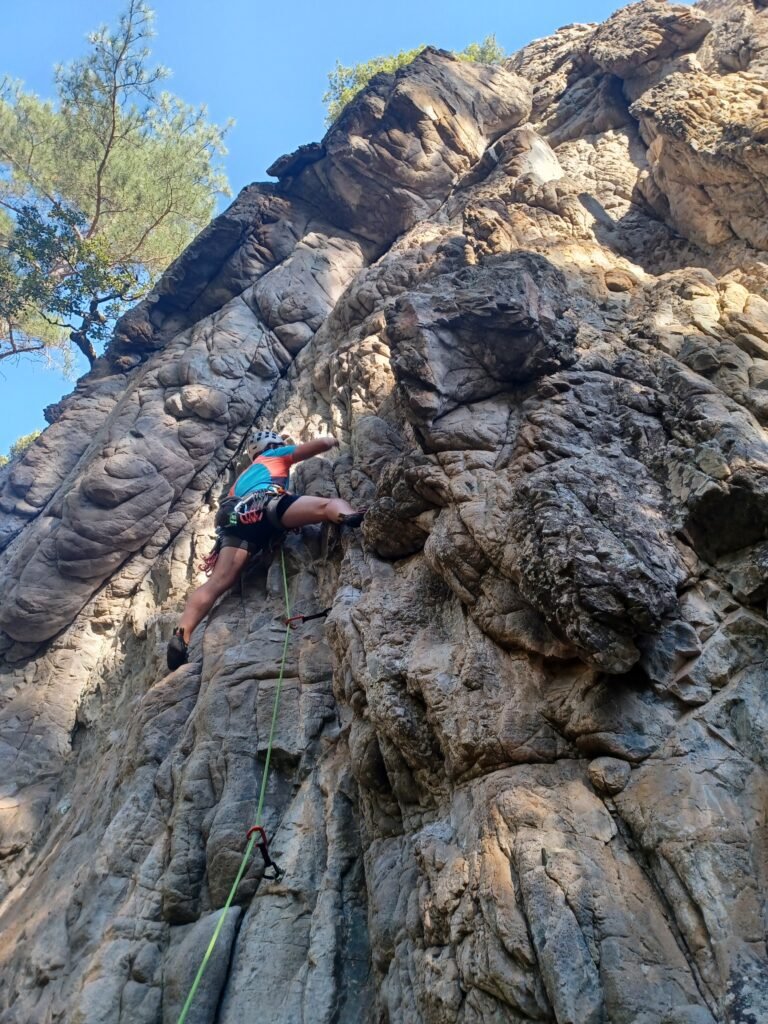
The nautical activities, a lot of sport activities in Ajaccio
Ajaccio is a mediterranean city located between the sea and the mountains. There are a lot of nautical activities you can pratice in this area ! In this way, you can diversify your sporting activities to make your entire family happy !
Sea kayaking
Ajaccio and its surroundings benefits from a coastline that has a lot of different landscapes. In this way, you can never be bored of what you see ! You can sail on the length of the coastline from Capo di Feno to the peninsula of Isolella while admiring the mountains in the background. We do offer two different guide kayaking tours near Ajaccio, the first one around the peninsula of Isolella. The second one around the little island named Isula Piana off the coast off the beach of Mare e Sole. On this beach you can also rent kayaks, pedalos, paddle boards or bodyboards during summertime !
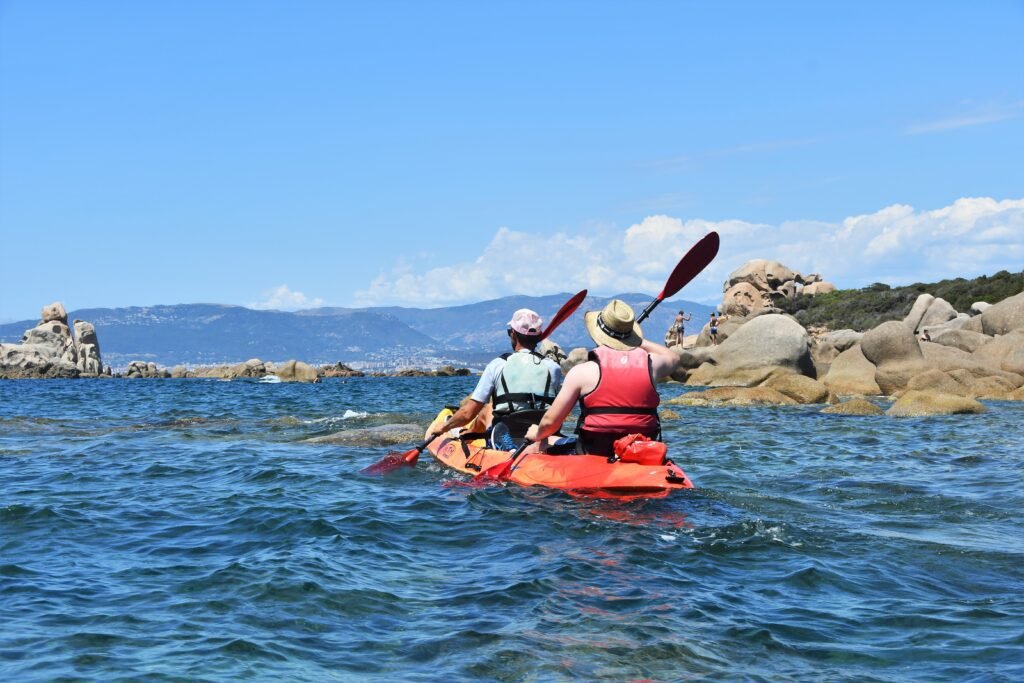
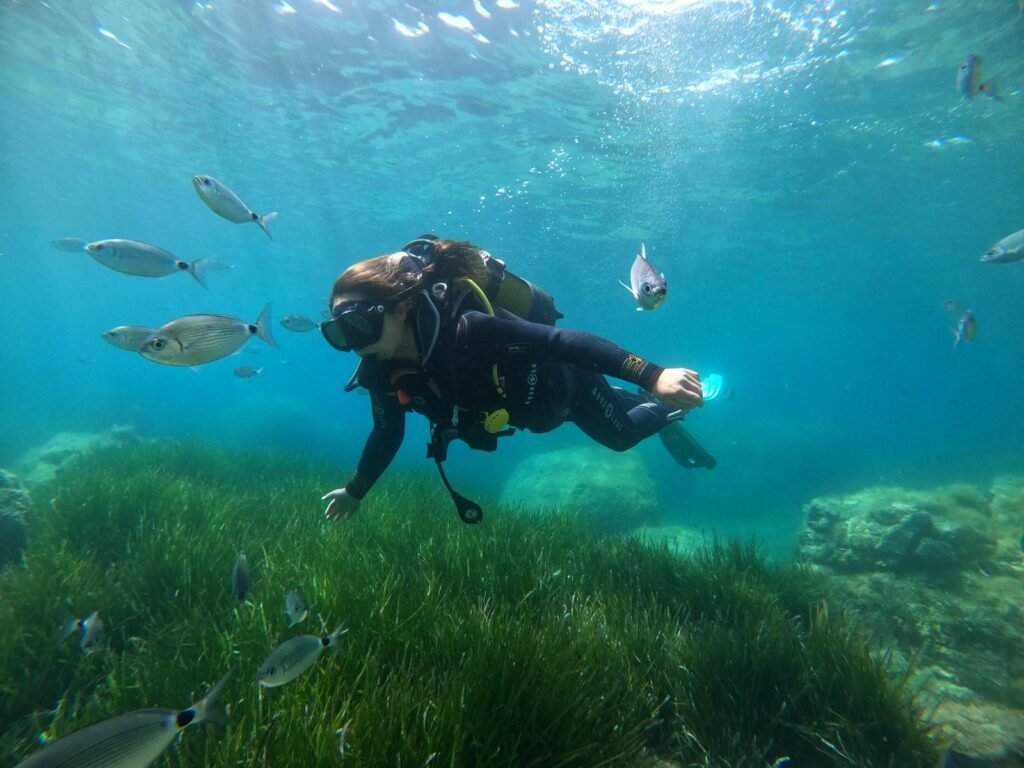
Scuba diving
Now is the time to discover what treasures the Mediterranean sea hiddes ! What better way to find out than in doing a first dive ? Agosta Plongée offers you a chance to dive on a famous spot near Porticcio named La Tête de Mort. In the city center of Ajaccio, Odyssée Plongée allows you to dive to explore the sea, a good way to start !
The jet ski
If, according to you, practice a sport go with adrenaline and thrill, maybe the jet ski is something that could suits you best ! A lot of compagnies are located in the coastline of Ajaccio, as Julien Jet Organisation or Jet Sensations !
The canyoning activity with Canyon Corse, sport activities and adrenaline near Ajaccio
Thank to its specific environnement, Corsica is a great place to practice the canyoning activity. In fact, thanks to its mountains and its rivers, the canyoning remains certainly a major sporting activity here in Corsica. Canyon Corse guides you safely through the gorges. You will make your way through crystal clear ponds and remarkable waterfalls.
The canyon of La Richiusa
There are a lot of equipped canyons in Corsica. Not far from Ajaccio you can find the canyon of La Richiusa which is one of the most famous canyons here is Corsica, is not the most famous one. The first hike in the mountains allows you to enjoy the amazing landscapes of Corsica. Rappelling descents, natural slides, jumps, zipline, just as many obstacles to overcome in these incredible turquoise ponds. Both beginners and experienced people will enjoy this amazing canyon !
The canyon Le Baracci
Le Baracci located near Propriano is quite different from La Richiusa we just talked about. The gorges are georgous thanks to the orange color of the granit, the atmosphere is quite particular there. You will enter this gorges and overcome many obstacles such as natual slides, jumps, zipline and rappelling.
In this way, la Richiusa and le Baracci may offer you the adrenaline rush you need in amazinc places ! Near Ajaccio, there is also the aquatic excursion of La Gravona. This activity is accessible and both children and adults will love it ! What a good way to practice sport activities with your entire family in Corsica !
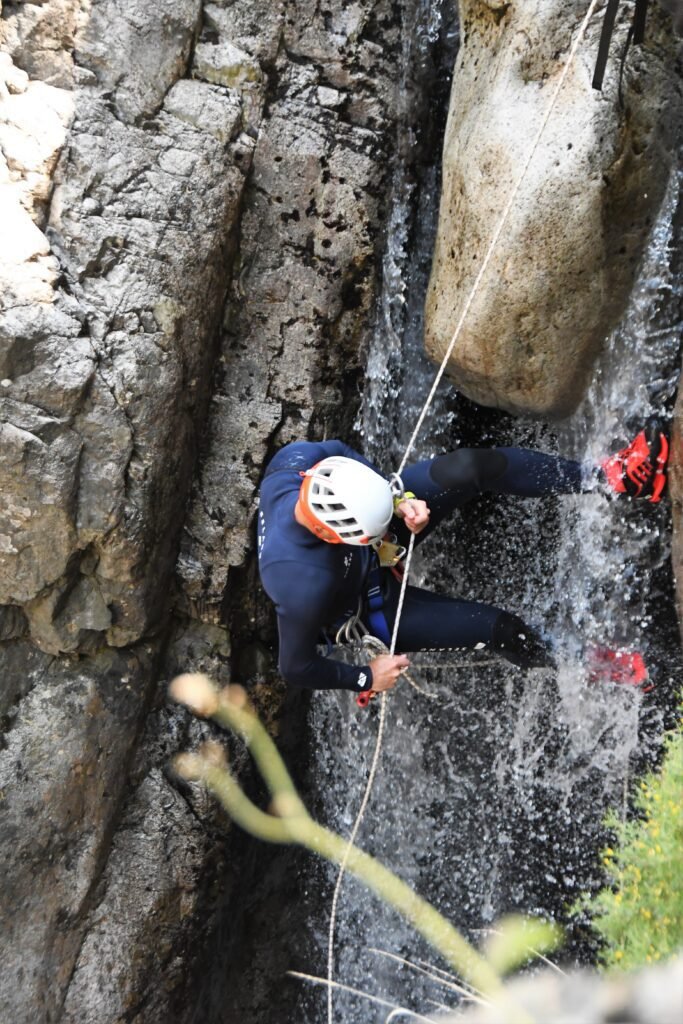
Mountain biking and road biking, outdoor sport activities in Ajaccio
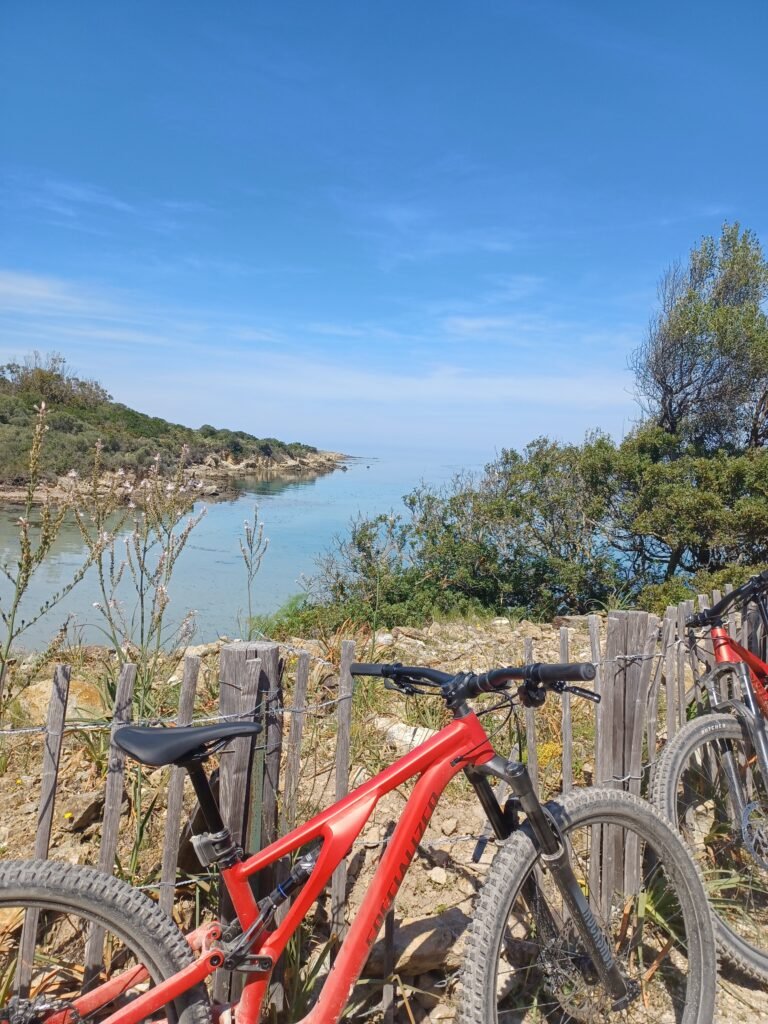
Over the years, Corsica has become a true cycle touring destination. The mountain biking and the road biking remain major outdoor activities here in Ajaccio. Thanks to its winding roads with incredible views and thanks to its hikings trails, Corsica is an amazing playground for all the bikes lovers. Plus, the mild weather we benefit from April to October allows us to practice these two sporting disciplines during a long period of time each year.
Mountain biking
A lot of hiking paths allow to discover every part of Corsica with a mountain bike. For example in Ajaccio, you can ride on the Coastal Path (Sentier des Douaniers) or on the Crest Path (Sentier des Crêtes) we talked about before on this article. You can also pace up and down all the hidden trails of the forest of Coti Chiavari to reach the former jail and its river dam.
Road biking
The road cycling offers many advantages, including being able to cover long distances in a short time.That is to say the roads are quite infinite. Plus, there is a large amount of secondary roads that are far less frequented by the drivers. There you can ride your bike safely while enjoying stunning landscapes.
You can visit the website of the FFC or the website of Visit Corsica if you need more informations. Guided tours are also setted up.
